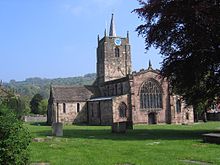St Mary's Church, Wirksworth
| St. Mary's Church, Wirksworth | |
|---|---|
 |
|
| Coordinates: 53°04′56″N 1°34′27″W / 53.08221°N 1.57404°W | |
| Country | United Kingdom |
| Denomination | Church of England |
| Churchmanship | Broad Church |
| Website | www.wirksworthteamministry.co.uk |
| History | |
| Dedication | St. Mary |
| Architecture | |
| Heritage designation | Grade I listed building |
| Designated | 24 October 1950 |
| Architectural type | Perpendicular Gothic |
| Specifications | |
| Length | 142ft |
| Width | 102ft |
| Administration | |
| Parish | Wirksworth |
| Diocese | Diocese of Derby |
| Province | Canterbury |
| Clergy | |
| Rector | Canon David Truby |
St. Mary's Church, Wirksworth, is a parish church in the Church of England in Wirksworth, Derbyshire. It is a Grade I listed building dating mostly from the 13th century, but with notable survivals from the Anglo-Saxon period. It was restored in 1870 by Sir Gilbert Scott.
The church is notable for its Anglo-Saxon carvings, and a large Anglo-Saxon coffin lid which was discovered in the churchyard in 1820. It is now mounted on the north wall of the nave. It appears to date from the second half of the 7th century. The church is also noted for containing an Anglo-Saxon carving of a lead miner, "Th' owd Man", the oldest representation of a miner anywhere in the world. It was moved here in 1863 from Bonsall church for safe-keeping and has never been returned. The parishioners of Bonsall have had a replica carved for their church.
It is one of the few remaining churches in Britain which still performs the ancient custom of Clipping the church. This takes place on the first Sunday after 8 September, the Sunday after the Feast of the Nativity of the Blessed Virgin Mary.
In the north aisle are the tombs of the Gell family. Sir Anthony Gell (d. 1583) has his statue on his tomb. Alongside is the simpler tomb of his father, Sir Ralph Gell.
The chancel contains the tomb of Anthony Lowe, a Gentleman of the Bedchamber who served Henry VII, Henry VIII, Edward VI and Mary I and died in 1555.
Abraham Bennet, the inventor of the gold-leaf electroscope and developer of an improved magnetometer.
The churchyard contains the tomb of Matthew Peat of Alderwasley, who died 11 December 1751, at an alleged age of 109 years and 10 months.
The church is in a joint parish with
...
Wikipedia
